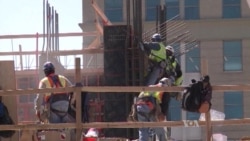U.S. companies added only 142,000 jobs in September, well below the 200,000-plus that many analysts were expecting. But American consumers are buying cars again, the housing market has picked up and the construction sector is looking for workers.
Aside from a decline in manufacturing, analysts say the U.S. economy, with the unemployment rate holding steady, is doing reasonably well.
So why the weak job numbers in September?
"Our take on this," said Barclay's chief economist Michael Gapen, "is that we think it clearly reflects a slowdown in global growth and some of the heightened volatility in financial markets that we saw in August."
The increased volatility coupled with the slowdown in Asia most likely made employers more cautious about hiring. It also means the U.S. central bank was probably right to delay an interest rate hike many expected would come in September, said PNC chief economist Gus Faucher.
“I think they were concerned about the impact of the international economy on the U.S. economy," he said. "That may be what we’re starting to see here, so they did decide to hold off on raising rates in mid-September. That being said, I still think that we may see a rate increase in either December or in early 2016.”
But Tom Porcelli, an economist at RBC Capital Markets, said that with the weak jobs report and "some of the other weakness that we are seeing across the globe, the odds [of a rate hike] get dinged for December."
August revision
August job figures were revised sharply lower to show only 136,000 jobs added that month, the Labor Department said Friday. That figure and the September number combined to result in the smallest two-month gain in employment in over a year.
The jobless rate, however, held steady at 5.1 percent. The unemployment rate is derived from a separate survey of households that showed 350,000 workers dropping out of the labor force last month, as well as a lower level of employment.
The share of the population in the work force, which includes people who have jobs or are looking for one, fell to 62.4 percent, the lowest level since 1977.
Average hourly wages fell by a cent to $25.09 during the month and were up only 2.2 percent from the same month in 2014, holding around the same levels seen all year and pointing to marginal inflationary pressures. But the wage picture could change as the labor market tightens and employers start competing for workers.
After the release of Friday's data, U.S. stock index futures slid, Treasury yields sank and the dollar fell sharply against a basket of currencies.
Long-term trends
Speaking at the White House on Friday, President Barack Obama said the employment report marked the 67th straight month of positive job growth.
“These long-term trends are obviously good news, particularly for every American waking up each morning and heading off to a new job," he said. "But we would be doing even better if we didn't have to keep on dealing with unnecessary crises in Congress every few months."
Obama was referring to years of partisan bickering in Congress over spending priorities. One such standoff shut down parts of the government in 2013, and another one could occur in December.
Some information for this report came from Reuters.










